
Frederick George Waterhouse was an English naturalist, zoologist and entomologist who made significant contributions to the study of the natural history of Australia.

Spyridium parvifolium, commonly known dusty miller, is a flowering plant in the family Rhamnaceae. It has dark green leaves and clusters of small, whitish flowers at the end of branches. It is widespread in eastern states of Australia.

Goodenia stobbsiana is a species of flowering plant in the family Goodeniaceae and is endemic to the north-west of Western Australia. It is a sticky, much-branched, perennial subshrub with egg-shaped to lance-shaped leaves with the narrower end towards the base and thyrses of blue flowers.
Cassinia compacta is a species of flowering plant in the family Asteraceae and is endemic to eastern Australia. It is a shrub with densely hairy stems, linear leaves and heads of yellow flowers arranged in dense corymbs.

Cassinia subtropica, commonly known as bushy rosemary, is a species of flowering plant in the family Asteraceae and is endemic to north-eastern Australia. It is shrub with woolly-hairy stems, lance-shaped to egg-shaped leaves and panicles of flower heads.
Persoonia brachystylis is a species of flowering plant in the family Proteaceae and is endemic to a restricted area on the west coast of Western Australia. It is an erect, spreading shrub with smooth bark, narrow spatula-shaped to lance-shaped leaves and yellow flowers in groups of ten to twenty.

Grevillea oligantha is a species of flowering plant in the family Proteaceae and is endemic to southern Western Australia. It is dense shrub with many erect branches, egg-shaped, lance-shaped or linear leaves, and groups of up to six brownish-yellow, orange or reddish-brown flowers with a pale yellow to reddish style.

Isopogon tridens, commonly known as the three-toothed coneflower, is a species of flowering plant in the family Proteaceae and is endemic to the southwest of Western Australia. It is a shrub with wedge-shaped leaves with two or three sharply-pointed teeth, and flattened-spherical heads of glabrous creamy white, sometimes purple flowers.
Petrophile multisecta, commonly known as Kangaroo Island conesticks, is a species of flowering plant in the family Proteaceae and is endemic to Kangaroo Island in South Australia. It is a prickly shrub with rigid, much-divided leaves with sharply pointed tips, oval to spherical heads of hairy cream-coloured flowers and oval fruit.
Pomaderris forrestiana is a species of flowering plant in the family Rhamnaceae and is endemic to south-western Australia. It is a low shrub with elliptic leaves, and small clusters of woolly-hairy flowers.
Lasiopetalum laxiflorum is a species of flowering plant in the family Malvaceae and is endemic to the south-west of Western Australia. It is a sticky, straggling subshrub or shrub with many densely hairy stems, egg-shaped leaves, and bright pink and dark red flowers.
Pomaderris rotundifolia is a species of flowering plant in the family Rhamnaceae and is endemic to Western Australia. It is an upright, spreading shrub that typically grows to a height of 0.1–1.5 m, its branchlets covered with star-shaped hairs. The leaves are more or less round leaves and the flowers are white to pink. In most respects it is similar to other species of Pomaderris occurring in Western Australia but has more prominent bracts, shorter pedicels and well developed petals. Flowering occurs from June to October.

Spyridium scortechinii is a species of flowering plant in the family Rhamnaceae and is endemic to eastern Australia. It is a shrub with egg-shaped to narrowly elliptic leaves, and dense heads of white, woolly-hairy flowers with brown bracts at the base.
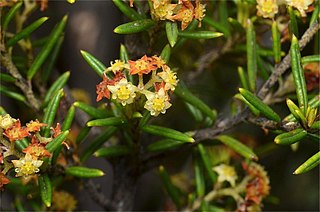
Spyridium daltonii is a species of flowering plant in the family Rhamnaceae and is endemic to Victoria in Australia. It is a shrub with softly-hairy branchlets, linear to narrowly elliptic leaves, and small groups of hairy, yellowish flowers.
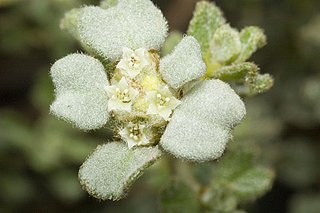
Spyridium halmaturinum, commonly known as Kangaroo Island spyridium, is a species of flowering plant in the family Rhamnaceae and is endemic to Kangaroo Island in South Australia. It is an erect, sticky shrub with densely softly-hairy young stems, leaves that are heart-shaped with the narrower end towards the base to broadly wedge-shaped or Y-shaped, and dense heads of white to cream-coloured flowers.
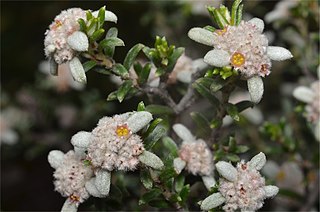
Spyridium leucopogon, commonly known as silvery spyridium, is a species of flowering plant in the family Rhamnaceae and is endemic to the Eyre Peninsula in South Australia. It is a small, slender shrub with narrowly linear leaves, and heads of woolly, white flowers.
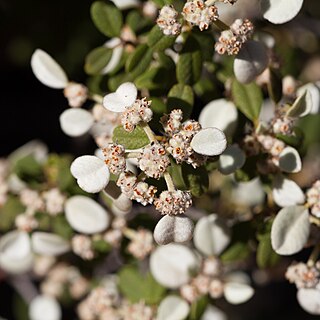
Spyridium phlebophyllum is a species of flowering plant in the family Rhamnaceae and is endemic to South Australia. It is a low shrub with rigid, egg-shaped leaves, and heads of flowers with a velvety, white floral leaf.
Spyridium scabridum is a species of flowering plant in the family Rhamnaceae and is endemic to Kangaroo Island in South Australia. It is a slender, erect shrub or small tree with oblong or narrowly egg-shaped leaves, and heads of sparsely hairy, white to cream-coloured flowers surrounded by densely hairy floral leaves.
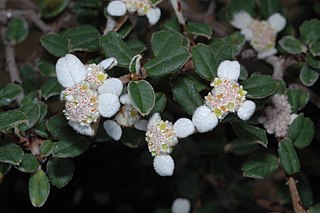
Spyridium thymifolium, commonly known as thyme-leaved spyridium, is a species of flowering plant in the family Rhamnaceae and is endemic to the south-east of South Australia. It is a small shrub with egg-shaped to almost round leaves, and heads of woolly-hairy flowers.
Spyridium villosum is a species of flowering plant in the family Rhamnaceae and is endemic to the south-west of Western Australia. It is a small shrub with shaggy-hairy branchlets, linear to oblong leaves and dense heads of hairy flowers with broad brown bracts at the base.












